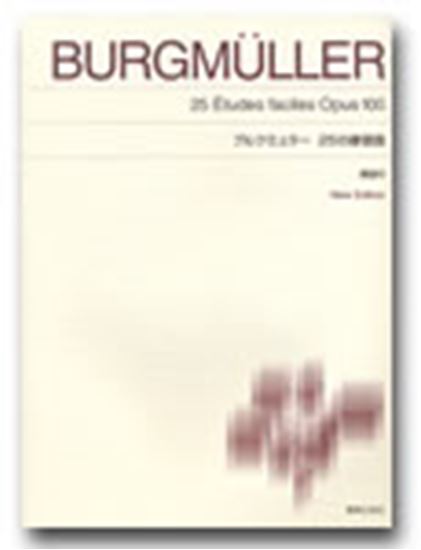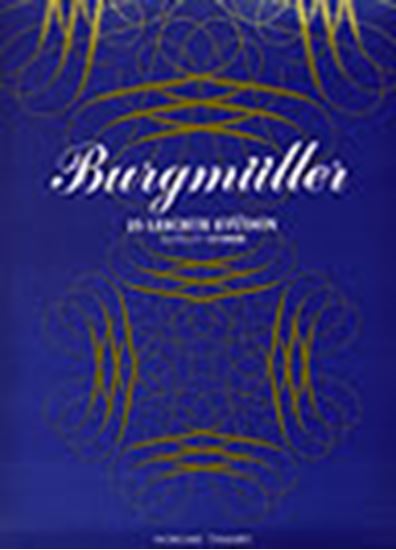Burgmüller, Johann Friedrich Franz : 25 Etudes faciles et progressives, conposées et doigtées expressément pour l'étendue des petites mains Barcarolle Op.100-22
Work Overview
Genre:barcarolle
Total Playing Time:1 min 30 sec
Copyright:Public Domain
Additional Notes:表記ゆれの例: バルカロール
Commentary (3)
Author : Sato, Takashi
Last Updated: January 31, 2022
[Open]
Author : Sato, Takashi
Barcarolle is a song of gondoliers descending the canals of Venice. It is characterized by a gentle 6/8 meter, wave-like accompaniment patterns, and long, sustained melodic lines. There are countless masterpieces titled "Barcarolle," including the three "Venetian Gondola Songs" from Mendelssohn's Songs Without Words, as well as works by Chopin, Fauré, and many others. Burgmüller's "Barcarolle" does not feature an arpeggiated accompaniment pattern like Mendelssohn's, but it employs a chordal accompaniment pattern that represents small waves, similar to that found in Chopin's "Barcarolle."
Performance Points (Original Tempo: Dotted Quarter Note = 72)
- The piece begins as if something is gradually emerging from a mist in the distance.
- Play the unison passages in both hands precisely.
- The chord with sf in measure 8 should sound as if the mist suddenly clears and the view opens up.
- For the melody starting from measure 13, the key to singing with a long breath is to pay attention to the note following a long note. The A-flat in measure 14 should decay while it sustains; if the following E-flat is played carelessly, it might sound like an accent. Control the volume of the E-flat to match the decay of the A-flat. The same applies to measure 18.
- The staccatos in measures 28 and 29 should not be too short.
(From Burgmüller 25 Etudes, To-on Edition (NS70))
Author : Iida, Arisa
Last Updated: March 15, 2018
[Open]
Author : Iida, Arisa
Musical example provided by: Ongaku no Tomo Sha
Author : Ooi, Kazurou
Last Updated: May 23, 2019
[Open]
Author : Ooi, Kazurou
The tempo for this piece is set at dotted quarter note = 72. However, from the author's personal perspective, a slightly faster tempo would make the piece clearer. The author's recommended tempo is around dotted quarter note = 80. The reasons are stated below.
The prelude begins pianissimo. If the pedal is held down continuously for the first 1-2 measures, it will become muddy, so the pedal should be used minimally. If this phrase, which starts pianissimo and further diminuendos to the A-flat on the second beat, is played at dotted quarter note = 72, there is a risk that it might sound "misterioso." The concern is that if the tempo is too slow, it could indeed become unsettling music. What are your thoughts on this?
Compound Meter and Tempo Flow
Compound meter is fundamentally understood as music that progresses forward without stopping. Since this piece is in 6/8 time, avoid excessive rubato and keep the music flowing. The indications for `riten` and `in tempo` are only present in measures 11-12 and 31-33; these should be strictly observed. However, avoid applying `rit` where not indicated. Nevertheless, when entering the final measure (m. 48), extending the last chord of measure 47 by about one second before entering m. 48 can effectively signal the end of the piece.
Other Points to Note
Throughout the piece, the harmonic progression primarily moves between tonic and dominant. Consequently, most measures have A-flat and E-flat in the bass. Within this framework, for example, in measures 17-20, the bass changes, and the key also shifts.
This is a very emotional section. Express it fully within the continuous tempo. Measures 37-40 are similar.
Regarding the melody notes where A natural appears (measure 22, beat 1; measure 26, beat 1), while there may be various opinions, the author considers A natural as a non-harmonic tone (Chromatic Lower
neighbor). This is indeed a very sensual or strong emotional expression, and it should be emphasized accordingly.
PTNA & Partner Channel Videos(18items) View More
Sheet MusicView More
Scores List (24)

(株)東音企画(バスティン)

(株)東音企画(バスティン)

(株)東音企画(バスティン)

(株)全音楽譜出版社

(株)ドレミ楽譜出版社

(株)音楽之友社

KMP(ケイ・エム・ピー) ケイエムピー

(株)ドレミ楽譜出版社

ハンナ(ショパン)

(株)ヤマハミュージックエンタテインメントホールディングス

デプロMP

(株)ドレミ楽譜出版社

(株)全音楽譜出版社

(株)ドレミ楽譜出版社

カワイ出版

カワイ出版

デプロMP

(株)ヤマハミュージックエンタテインメントホールディングス

デプロMP

(株)音楽之友社

(株)共同音楽出版社

Neil A. Kjos Music Company



















